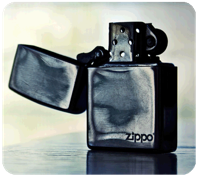 Thanks to tough legislation and widespread public education, the number of U.S. smokers has declined 50 percent since the habit’s heyday in the 1950s. Although this significant customer drop-off has hurt many tobacco companies, business has been booming over the last few years for the iconic lighter brand Zippo. The Bradford, PA-based company earned $200 million in sales last year, a record for the lighter maker. What’s more, Zippo’s expanded global presence and diversified product line has increased sales by 14 percent over the last three years.
Thanks to tough legislation and widespread public education, the number of U.S. smokers has declined 50 percent since the habit’s heyday in the 1950s. Although this significant customer drop-off has hurt many tobacco companies, business has been booming over the last few years for the iconic lighter brand Zippo. The Bradford, PA-based company earned $200 million in sales last year, a record for the lighter maker. What’s more, Zippo’s expanded global presence and diversified product line has increased sales by 14 percent over the last three years.
The company’s non-smoking CEO Greg Booth has been credited for much of the turnaround, but at its heart Zippo is a family operation. George Blaisdell created the legendary lighter in 1932 after witnessing a friend struggle to fire up a cigarette in the blustery Allegheny Mountains. The lighter’s windproof chimney and sturdy metal design immediately struck a chord with consumers. Zippo also pulled in the public by guaranteeing the lighters for life, so long as its owner was willing to send it to the factory for repairs. Finally, the company reached its status as an All American brand after the U.S. military gave Zippos to all enlisted soldiers in World War II.
Following Blaisdell’s death in 1978, nonfamily CEOs began to run Zippo’s day-to-day operations. However, this did not stop family members from arguing about how the company should be run. By the 1990s increased infighting had led Blaisdell’s daughter Sarah and her son Duke to buy out the rest of the family. Stability in the boardroom didn’t lead to consistent sales, though, and as the 2000s rolled around Zippo was struggling. Booth soon took up the mantle of CEO and immediately set out to capture the interest of younger consumers. He hammered out licensing agreements with brands like Jack Daniels and the TV show Sons of Anarchy, using these properties as inspiration for lighter designs. The company now produces more than 30,000 different designs each year. Booth also expanded operations in China, even going so far as to open Zippo’s first brick-and-mortar retail locations in the country. All told, 60 percent of the company’s revenues now come from overseas. Zippo also draws sales from a variety of camping products as well as a clothing line, leaving the company poised to continue burning brightly even as the number of smokers flames out.
Questions:
- Why was China a logical market for Zippo expansion?
- Can licensing agreements sometimes change the perception of a product?
Source: Abram Brown, “Sparking Zippo,” Forbes, September 8, 2014. Photo by: Shadi Samawi.
